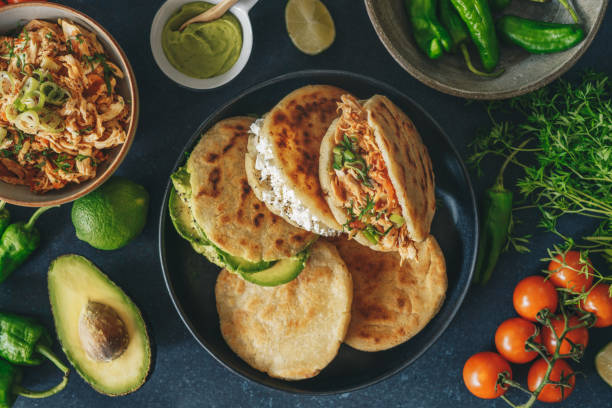All over the world, Indian cuisine is often associated with curry. It's hard to generalize because there are so many spices and variations, but if you're not familiar with the country's culinary style, you can't really avoid it.
India is home to many cultures and subcultures, each with
their own unique cooking methods, which have little in common. The preparation
methods are different, as are the flavors, textures and spices used. However,
in India, three spices are mainly used: Turmeric (haldi), salt (namak) and red
chili powder (mirch). On this basis, Indian cooks create a wide variety of
dishes by varying the spices.
In this article, we present a few varieties of North Indian
bread, both common and lesser known. The term "North India" in the
cultural sense includes Delhi, Punjab, Jammu and Kashmir, Himachal Pradesh,
Uttar Pradesh, Uttaranchal and Rajasthan. Apart from the cosmopolitan city of
Delhi, they all have their own culture and culinary tradition. So it is a bit
unfair to lump them all together when it comes to food, but it suits the
purpose of this article.
In northern India, there are many baked breads (tawa),
usually made from flourless dough. The dough is often made of coarse flour,
mixed with water and a little salt, and kneaded to a soft, pliable consistency.
Different kinds of bread can be made from this dough, as illustrated below.
Roti
or Chapati
These breads are made by rolling small balls of dough into
round shapes (about 1-2 mm in diameter) and baking them in a hot pan until
golden. There are different types of roti, some examples of which are shown
below.
Phulka
A close relative of roti, it is fried on one side in a pan
and then cooked over an open fire, which causes the roti to swell into a phulka.
"Phul" means "to swell", hence the origin of the word
"phulka".
Makki ki Roti
This popular winter roti is made with corn flour (makki ka
atta). After preparing a simple dough with water (and grated vegetables such as
radishes and carrots), the dough is very fragile and does not hold together, so
a ball of dough is pressed onto a cloth or flexible plastic. When the dough is
the size of a roti, it is usually turned in a hot pan and served with pickled
vegetables or Sarson ka saag (mustard seeds).
Ulte tave ki Roti
The literal translation means "roti cooked in an
inverted pan". Roti is prepared in the same way as regular roti, but they
are about twice as thick as regular roti. Both sides of the uncooked roti are
moistened with water and placed on a hot frying pan. This makes them stick to
the pan more easily and they become desirable when the pan is turned over and
the rotis are exposed to direct heat. Rotis are usually served with a non-vegetarian
dish, but this is usually a matter of personal preference.
Missy Roti
Missy roti is a roti in which different types of flour and
spices are added to the normal dough as described above. There is no fixed
recipe, everyone decides here himself. A simple example is to mix equal parts
whole wheat and chickpea flour with red chili powder, salt, Kasuri methi, and a
small amount of cumin, then add water to make a soft dough. If you wish, you
can add a small amount of oil. Once the paste is ready, it is cooked in a hot
pan like a normal roti.
The Tandoor
The tandoor is a vertical cylinder made of an outer metal
shell and a very thick inner layer of fired clay. The Rotis cooked inside the stick
to the inner wall. When cooking meat or preparing shish kebabs, the food is
skewered on long metal skewers, hence the name of the popular shish kebab
"Sheikh Kebab".
Tandoori Roti
It is similar to Ulte Tave Ki Roti in that it is rolled, but
prepared in the tandoor. After being rolled, the rotis are placed on the inner
wall of the tandoor and cooked as is. Tandoori rotis are usually a little more
than twice as thick as normal rotis.
In Kashmir, there is a version called Lavasa, which is also
quite tasteless, as no spices are used. The dough is made of refined white
flour and not wholemeal flour like the tandoori roti. This dish goes well with
almost anything but is usually served with a highly spiced Kashmiri lamb stew.
Tandoori Paratha
Tandoori paratha is prepared in the same way as Lacha paratha.
The only difference is that it is prepared in a tandoor and not in a hot pan.
Naan
Naan is made from a refined flour dough to which an expander
is added. Some use the fermented dough, some use yeast and some add active yogurt
to the dough. However, the end result is the same: the dough must rise. The
size of the naan varies from a few centimeters to the monster I ate which was a
little over a meter in diameter. Naan is usually prepared in a tandoor, but an
oven is also sufficient. The charcoal, however, gives a taste that traditional
ovens do not achieve.
Stuffed naan (Amritsar)
Amritsar is an important city in Punjab. Stuffed naan, also
known as Amritsar naan, is named after this city. Stuffed naan is made from
naan dough, has a filling similar to paratha, and is usually rolled into a round
shape. It is then stuck to the inside wall of the tandoor and cooked.
Kulcha
Kulcha is a
kind of patty cooked with refined flour. It is acidified with baking powder and
active whole milk yogurt. It can be eaten plain or lightly toasted in a pan or
toaster. It has a slightly sour taste and can be decorated with chopped
coriander leaves. Kulchas are usually served with chickpea curry, but they are
also delicious with Indian pickles for breakfast.




